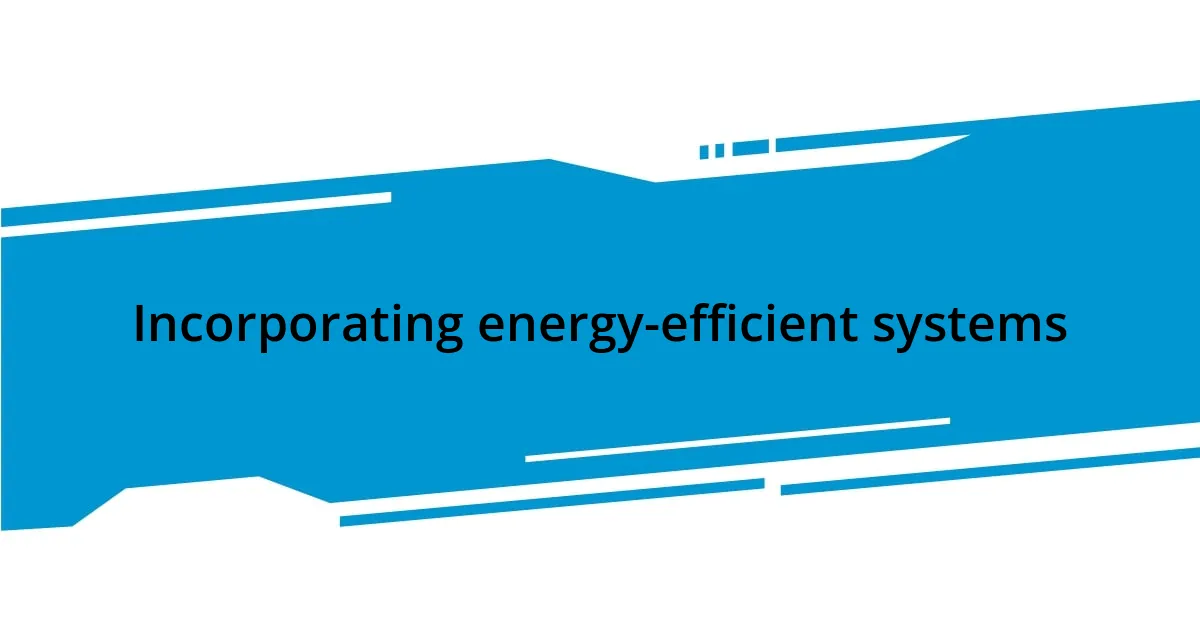Key takeaways:
- Eco-friendly amenities enhance living spaces while promoting sustainability through choices like biodegradable products and energy-efficient appliances.
- Switching to sustainable materials and practices positively impacts well-being, indoor air quality, and can increase property value.
- Incorporating energy-efficient systems, such as LED lighting and smart thermostats, leads to lower utility bills and greater comfort.
- Engaging in water conservation and reducing waste through practices like rainwater collection and composting fosters a healthier environment.

Understanding eco-friendly amenities
Eco-friendly amenities can be a bit of a buzzword these days, but what do they really mean? To me, they represent choices that not only enhance our living spaces but also respect the planet. Whether it’s biodegradable soaps or energy-efficient appliances, these elements work together to create a more sustainable lifestyle.
I remember the first time I swapped out my usual cleaning products for eco-friendly alternatives. At first, I was skeptical—could they really be as effective? But to my surprise, not only did my home feel cleaner, but it also smelled fresh without the harsh chemical scents I had grown so accustomed to. It made me wonder, how many simple changes could we make in our daily routines to contribute to a healthier planet?
In understanding these amenities, we must also consider their impact on our well-being. For example, using natural materials in our home decor can foster a sense of tranquility that synthetic materials simply can’t replicate. Have you ever walked into a space that felt like a breath of fresh air? That’s the beauty of eco-friendly choices; they enhance our environment while nurturing our connection to nature.

Benefits of eco-friendly amenities
Choosing eco-friendly amenities offers numerous advantages that extend beyond environmental impact. One significant benefit is the reduction of harmful chemicals in our living spaces. I still recall the moment I replaced conventional air fresheners with a natural essential oil diffuser. Not only did my home smell more inviting, but I also felt a tangible difference in my well-being—no more headaches from overwhelming synthetic fragrances. This personal shift illustrated to me how simple changes can lead to a healthier home environment, which ultimately uplifts my mood and energy.
Another compelling aspect of eco-friendly amenities is their potential to lower utility bills. When I installed energy-efficient appliances in my kitchen, I was pleasantly surprised to see a noticeable dip in my monthly expenses. This financial advantage feels rewarding because every time I save a bit of money, I also contribute positively to the planet. It almost feels like two rewards in one: nurturing my budget while nurturing the Earth.
Lastly, eco-friendly amenities can increase the overall value of your property. When I decided to use sustainable materials for home renovations, like bamboo flooring, I not only created a beautiful space but also positioned my home as more appealing to prospective buyers. The growing interest in sustainable living means homes with eco-friendly features often stand out in the market. It’s an empowering realization—by making responsible choices, I’m not just improving my life but potentially benefiting financially in the long run.
| Benefits | Description |
|---|---|
| Healthier Living | Reduces exposure to harmful chemicals, improving indoor air quality. |
| Financial Savings | Lowers utility bills through energy-efficient appliances and fixtures. |
| Increased Property Value | Enhances market appeal and value, attracting eco-conscious buyers. |

Choosing sustainable materials
Choosing sustainable materials is a journey that has transformed not just my living space, but my mindset as well. I vividly remember when I first chose organic cotton for my bedroom sheets. The experience of sleeping on them felt like a cozy embrace from nature itself. It was a gentle reminder that what we choose to surround ourselves with—down to the fabric on our bed—can directly impact our well-being. Natural materials breathe better and contribute to a serene atmosphere, which is invaluable in our fast-paced lives.
Here are some considerations when selecting sustainable materials:
- Durability: Opt for materials that are built to last, reducing the need for frequent replacements.
- Biodegradable Options: Look for items that break down easily after their lifespan to minimize waste.
- Source: Investigate where materials come from; local options can lower carbon footprints.
- Low VOCs: Choose products with low volatile organic compounds to maintain good indoor air quality.
- Recycled Materials: Consider items made from recycled content to give new life to old resources.
Engaging with sustainable materials means embracing a lifestyle that values both comfort and the planet. Whenever I pick something eco-friendly, I feel a deeper connection to the choices I make—it’s as if I’m casting my vote for a healthier future with every decision.

Incorporating energy-efficient systems
Incorporating energy-efficient systems into my home was one of the best decisions I’ve made. When I switched to LED lighting, the transformation was immediate. I remember feeling a genuine sense of relief watching my energy bills drop while enjoying a cozy ambiance. It made me think: why settle for less when simple choices lead to such significant rewards?
I also took the plunge and installed a smart thermostat. It amazes me how much control I now have over my energy use. I love being able to adjust the temperature from my phone, especially on those chilly winter mornings when all I want to do is stay snuggled up in bed a little longer. This gadget not only enhances my comfort but actively contributes to reducing waste. Isn’t it delightful to think about how technology can work for us in such an eco-friendly way?
Additionally, embracing energy-efficient systems often opens up a world of unexpected benefits. For example, when I added energy-efficient windows, I noticed a remarkable increase in comfort. No more drafty corners or high heating costs during winter! Each little improvement brought a sense of empowerment, knowing I was actively participating in a larger movement toward sustainability. Isn’t it rewarding to feel that you’re making a difference, one upgrade at a time?

Promoting water conservation practices

Promoting water conservation practices
One of my favorite ways to promote water conservation has been installing low-flow fixtures in my home. The moment I replaced my old showerhead with a low-flow model, I was amazed to discover how much water I was saving without sacrificing my shower experience. It’s refreshing to know I can enjoy a revitalizing shower while still respecting our precious water resources. Isn’t it incredible how a simple change can lead to such an impact?
I’ve also made it a habit to collect rainwater for my garden. Watching the rainwater fill up my barrels feels like nature’s way of giving back—it’s a beautiful symbiosis of practicality and eco-friendliness. I’ve noticed my plants thriving more than ever, all thanks to this natural resource that would otherwise go to waste. Doesn’t it feel good knowing you are nurturing life while conserving water at the same time?
Lastly, I often remind myself and those close to me about the power of mindful water use. Every time I brush my teeth, I turn off the tap, and I encourage friends to do the same. It’s amazing how these tiny daily choices can collectively lead to significant water savings. Have you ever thought about how your little actions add up? I know that when I consciously choose to save water, I’m not just making a choice for myself; I’m contributing to a larger movement toward sustainability and encouraging a culture of consideration for our environment.

Selecting non-toxic cleaning products
When I began searching for cleaning products, I was astonished by how many options claimed to be eco-friendly but were still loaded with harmful chemicals. I remember standing in the aisle, reading labels like they were a foreign language. I made a deliberate choice to seek out brands that not only highlighted being non-toxic but also prioritized transparency in their ingredient lists. It felt empowering to choose products that I could trust to clean my home without compromising my family’s health or the environment.
Each time I try a new non-toxic cleaner, I pay special attention to the scent; harsh fragrances can be a huge red flag for me. I still vividly recall the first time I used a vinegar and essential oil-based cleaner—it smelled fresh without overwhelming my senses. This experience reminded me that natural ingredients can be just as effective, if not more so, than their chemical counterparts. Isn’t it remarkable how nature has provided us with powerful alternatives?
I often think about how my choice of cleaning products reflects my values. It’s a small, yet significant step toward fostering a healthy home and protecting the planet. The sense of satisfaction I feel when I’ve tidied up with non-toxic products is palpable. It’s not just about having a clean space; it’s about creating an environment where everyone can thrive. Have you ever considered how your cleaning choices contribute to a bigger picture? Trust me, each decision can lead to a ripple effect that inspires others to follow suit.

Creating a low waste environment
I’ve found that reducing waste in my daily life is not just beneficial for the environment; it also brings a sense of fulfillment. For example, I started my zero-waste journey by swapping out disposable bags for reusable ones. It’s astonishing how something so simple can lead to less clutter in my kitchen and contribute to the reduction of plastic pollution. When I see those colorful reusable bags hanging by the door, I feel a sense of pride knowing I’m making a conscious choice every time I go shopping.
In my quest for a low-waste environment, I’ve embraced the art of upcycling. A few months back, I transformed an old wooden crate into a charming garden planter. It was a fun project that not only diverted waste from the landfill but also brightened up my patio space. There’s something uniquely satisfying about giving new life to items that might otherwise be forgotten. Have you ever thought about how a little creativity can repurpose items into something useful? It makes me reflect on the potential hidden in the everyday objects around us.
One of my most rewarding practices has been implementing a compost system at home. I remember the first time I tossed in vegetable scraps and eggshells—it felt like I was returning a piece of myself to the Earth. Watching the scraps decompose into nutrient-rich soil makes me appreciate the cycle of life. It’s humbling to know that instead of filling a landfill, I’m nourishing my garden. Isn’t it remarkable how a small change in our habits can lead to a larger impact on our waste footprint?
















